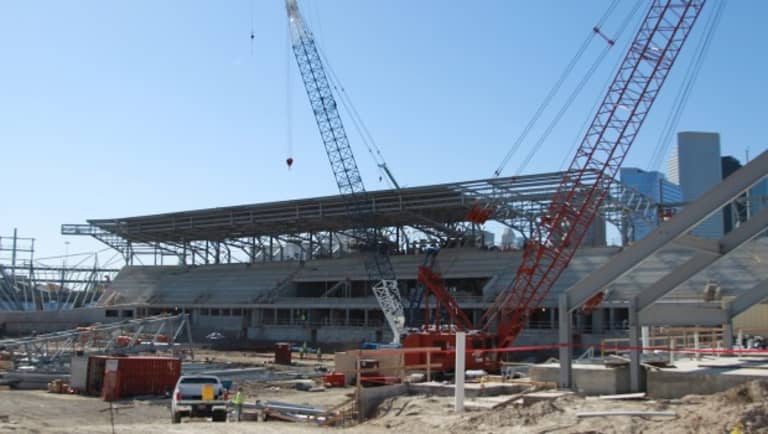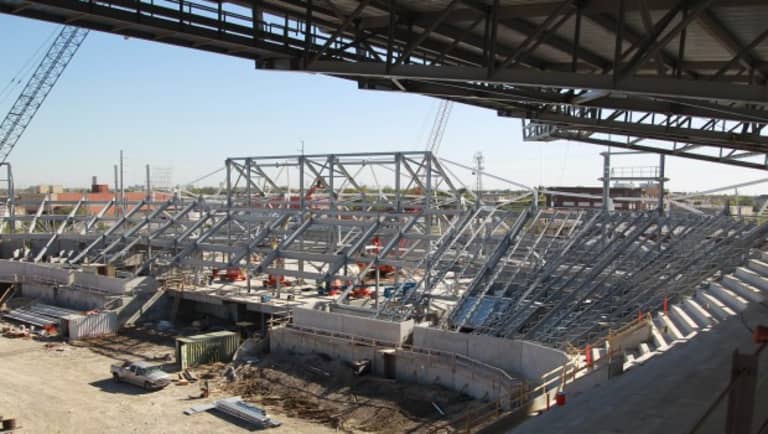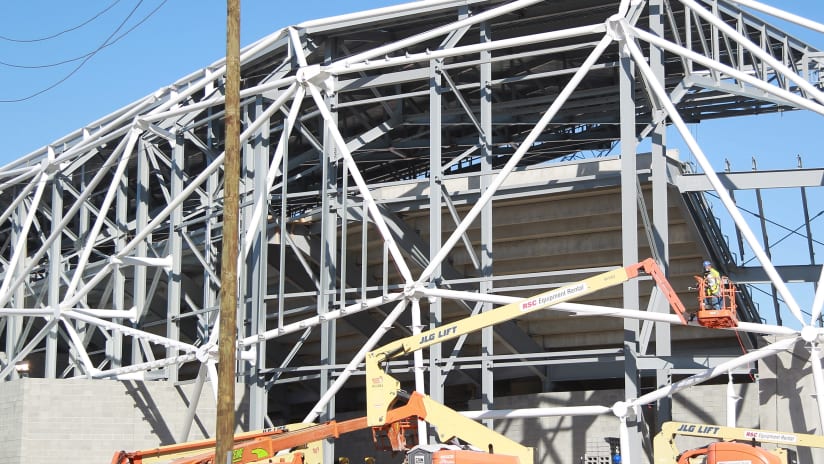Touring the Dynamo Stadium is a blast. I had the chance to walk around with Manhattan Construction project manager Matt Doffing on Tuesday, and I was incredibly impressed by how much progress had been made since my last visit to the stadium site a month earlier.
VIDEO: Doffing discusses stadium risers, progress
But there were still dozens of little questions I wanted to ask about just how everything was going to work, and Doffing patiently answered the most relevant ones. Hopefully you find them helpful:
We’ve all seen the precast risers being installed to form the sideline seating in the 200 level, but when will the 100 level be defined?
“We’ll start digging on that around the first of November. We’ll start in the southwest corner and start coming to the north. We’ll dig all that dirt out, and we’ll put in a structural select fill. That’ll be on a slope, and then we’ve got a system that you can slide down [the sideline], and we’ll pour that in[to molds to make the seating rows.]”
If the precast risers are not being used in the end zones, what will go underneath the seating in the 200 level on the north and south ends?
“It’s aluminum planking that goes in. It’s a more cost-effective solution, plus it’s down where some of the rowdies are, so it’ll make some noise. Where the precast ends, you can see the transition. It’s going to be gray aluminum versus concrete, so you’ll see a clear definition between them, but it’s all continuous.”
In other words, while fans in the end zones may be standing on different material than those on the sidelines, they will be part of one continuous bowl and there should be no obvious gap or separation between the sideline and end-line seating.

Looking up at the roof on the west sideline, there are exposed support beams and catwalks clearly visible – will those still be visible in the finished product?
“That’s exactly how you’re going to see it. We’ve got the catwalks going in to support the sports lighting, which we’ll start next week, so that we don’t have light towers. You can see the extent of the truss [pointing toward the southwest corner, where steel curves toward the south beyond the canopy], and that’s how it’s going to look in every corner. Right now everything’s tracking on schedule, and the steel’s been moving really well.”
How does the aluminum skin, the exterior feature most responsible for making the stadium unique, attach to the steel already in place?
“The white tubing sets up the geometry for the exterior skin. On top of that, we get an anodized aluminum purlin. They all run vertically. What goes on top of that is the expanded aluminum mesh, and that’s what you’ve seen on the renderings. On top of that white tubing, it’s going to make all of those facets that you see, so it’s starting to come together now.”
This is where he started to lose me. A purlin, in this case, is an aluminum road maybe 1-2 inches thick running vertically and connecting to the white diagonal tubes in special clips that have to be able to rotate to hold the purlins perfectly vertical despite the different angles of the beams. The aluminum mesh will then attach to the purlins horizontally, covering most of the structural steel but allowing air to circulate throughout the concourse. The white tubing will give the skin its shape and be partially visible, but it will not be quite as vivid as it is now.
What kind of finish will the cinder block walls on both sides of the concourse have, and what color will they be?
Doffing said he expects most concourse walls and some of the exterior walls to be painted Dynamo orange, although that may be one of the last steps in the construction process. The designs for the interior walls are being developed, adding to the spectator experience within the stadium.
The stadium currently has a break in the northeast corner to allow for traffic into the stadium bowl. Is that a permanent feature?
No, the northeast corner will be closed and fully integrated as part of the stadium structure at some point after the cranes have erected the roof canopies and can be moved out.
How will the building in the south end zone integrate with the main stadium structure?
There will be access points between the main concourse in the south end zone and the building, but the team and officials’ locker rooms will be on a lower level, with primary access to the field via the main ramp underneath the south end zone.

Which seats in the south end zone will be removable to allow for concerts and additional events on the stage?
This got a bit complicated, but it seems like the 200-level seating will be permanent, with only a few sections [in the 100 level] directly behind the goal capable of being removed. They are intended to integrate into the 100-level seating structure during games, however, without a noticeable difference from the sections on either side. Staging material will be used to support the removable seats, and that material will then be reconfigured into a concert stage after the seats are removed via forklift. The system is designed to be fan-friendly while providing flexibility and efficiency for event management.


